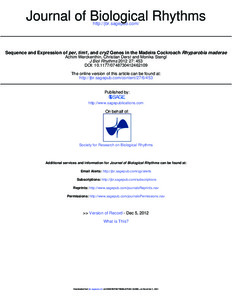Suche
Anzeige der Dokumente 1-7 von 7
Aufsatz
 Signaling of Pigment-Dispersing Factor (PDF) in the Madeira Cockroach Rhyparobia maderae
Signaling of Pigment-Dispersing Factor (PDF) in the Madeira Cockroach Rhyparobia maderae
(2014)
The insect neuropeptide pigment-dispersing factor (PDF) is a functional ortholog of vasoactive intestinal polypeptide, the coupling factor of the mammalian circadian pacemaker. Despite of PDF's importance for synchronized circadian locomotor activity rhythms its signaling is not well understood. We studied PDF signaling in primary cell cultures of the accessory medulla, the circadian pacemaker of the Madeira cockroach. In Ca2+ imaging studies four types of PDF-responses were distinguished. In regularly bursting type ...
Aufsatz
 The Diacylglycerol Analogs OAG and DOG Differentially Affect Primary Events of Pheromone Transduction in the Hawkmoth Manduca sexta in a Zeitgebertime-Dependent Manner Apparently Targeting TRP Channels
The Diacylglycerol Analogs OAG and DOG Differentially Affect Primary Events of Pheromone Transduction in the Hawkmoth Manduca sexta in a Zeitgebertime-Dependent Manner Apparently Targeting TRP Channels
(2018-07-24)
For the hawkmoth Manduca sexta accumulating evidence suggests that pheromone transduction acts via a metabotropic signal transduction cascade, with G-protein-dependent phospholipase C (PLC) activations generating diacylglycerol (DAG) and inositol trisphosphate as the primary events in hawkmoth pheromone transduction. In contrast, ionotropic olfactory receptor (OR) coreceptor (Orco)-dependent mechanisms do not appear to be involved. In hawkmoths pheromones activated a specific sequence of PLC-dependent ion channels ...
Aufsatz
 No Evidence for Ionotropic Pheromone Transduction in the Hawkmoth Manduca sexta
No Evidence for Ionotropic Pheromone Transduction in the Hawkmoth Manduca sexta
(2016-11-09)
Insect odorant receptors (ORs) are 7-transmembrane receptors with inverse membrane topology. They associate with the conserved ion channel Orco. As chaperon, Orco maintains ORs in cilia and, as pacemaker channel, Orco controls spontaneous activity in olfactory receptor neurons. Odorant binding to ORs opens OR-Orco receptor ion channel complexes in heterologous expression systems. It is unknown, whether this also occurs in vivo. As an alternative to this ionotropic transduction, experimental evidence is accumulating ...







